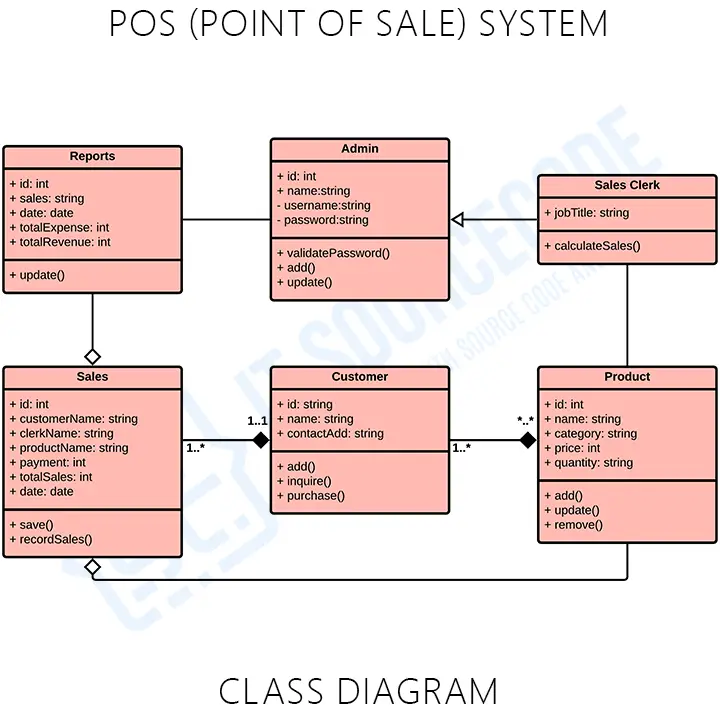Point of Sales (POS) System Class Diagram
A class diagram is used to represent, explain, and document the parts (classes) of a point of sale (POS) system. It can also be a reference or way to create executable software code.
Additionally, class diagrams provide an overview of the system’s classes, functions, and relationships.
Project Overview
| Name: | POS (Point of Sale) System Class Diagram |
| UML Diagram: | Class Diagram |
| Users: | Store or Company Owners and Cashiers |
| Tools Used: | Any Diagram tools that provide use case diagram symbols. |
| Designer: | ITSourceCode.com |
What is a Point of Sales (POS) System?
The operating system that retailers employ to run their retail stores is point-of-sale software. It aids businesses in managing sales and keeping track of their goods, personnel, and clients. POS systems that operate in the cloud are becoming more and more common among retailers nowadays.
Additionally, the POS system includes reports that enable business owners to track sales growth and shop performance over time. It can also take place offline or online, and receipts can be printed out or created electronically.
What is a Class Diagram?
A UML class diagram for POS management system is crucial and useful for system development. This is because the class diagrams are very effective in showing the system’s structure in detail, including the structures of each class. This works best with other Point of Sale Management System UML Diagrams.
Additionally, the class diagram blueprints show how things in the system work and are related. It also offers the system’s activities and the services it provides. Therefore, a class diagram defines the physical components of a system and can directly relate to object-oriented languages.
Point of Sale System Class Diagram
This simple class diagram gives you the exact details about the system’s class characteristics and methods. It also clarifies the connections of classes in the system.
Here, I will be showing you the sample constructed class diagram provided with its attributes and methods. This is from the simple idea of the POS’s common function.

The illustration shows a simple idea of how the class diagram works. It resembles a flowchart in which classes are present in boxes with three rectangles in each. The top rectangle has the class’s name; the middle holds the class’s properties, and the bottom contains the class’s methods.
The classes identified for POS System were the admin, reports, sales clerk, sales, customer, and product. Their roles are in the middle part and called their attributes. The function of each class is in its’ methods.
You can edit this diagram and it is up to you how will you create your class diagram. However, you need to be precise with your information and consider the decisions included.
Downloadable Pdf File
How to Draw a Class Diagram?
Time needed: 1 minute
Steps in creating Class Diagram for Point of Sale System.
- Step 1: Familiarize Class Diagram Components
Class Diagram Components are used to create class diagrams. They are the primary components that build the class diagram.
To plot the class diagram you will need the class name, its attributes, methods, and their access (visibility). You will base the diagram on the evaluated information to have the exact Class Diagram. - Step 2: Determine the targeted users
Classes are the main part of the diagram and it is presented in a box with three main partitions. It should be declared properly because it could be converted to codes.
- Step 3: Analyze the activities included
Attributes of a class should be placed in the middle part of a class. They were then assigned visibility symbols. This visibility has something to do with the codes.
The operations will be placed at the bottom of a class and represent the functions of a class within a system. - Step 4: Plot the Class Diagram
To map the relationship between the classes, you also need to know the meaning of the symbols at the end of each line that connects them. The ends represent different meanings and relations between two or more classes.
Conclusion
The class diagram is a modeled diagram that explains systems classes and relationships. It can depict the names and attributes of classes, as well as their links and methods that make up the software.
Moreover, the class diagram is the most essential type of UML diagram and is critical in software development. It is an approach to showing the system’s structure in detail and part by part.
Related Article:
Inquiries:
If you have inquiries or suggestions about the Class Diagram discussion, leave us your comments below. We would be glad to hear to concerns and be part of your learning.

